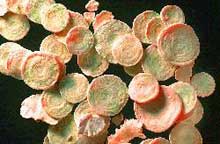
Agricultural breeders have long observed that when plants or animals from different strains are interbred, the offspring tend to be stronger, healthier or generally more fit than either of their parents, although no one knew why this occurred. Now plant geneticists investigating the maize (corn) genome at Rutgers’ Waksman Institute of Microbiology have discovered a possible explanation for this phenomenon, known as heterosis or hybrid vigor.
The Rutgers findings, presented by research

Finding has implications for future of biodiversity
A significant number of organisms that survived the five greatest mass extinctions in Earth’s history subsequently failed to achieve evolutionary success, according to a new study funded by the National Science Foundation (NSF) and conducted by University of Chicago scientist David Jablonski.
“It’s clear that there is a lot of evolutionary action in the aftermath of mass extinctions,” said Jablonski. “During the re

Scientists at the University of North Carolina have successfully treated mice with hemophilia A using a new approach to gene therapy – RNA trans-splicing. The experimental procedure repairs a mutated section of the gene responsible for hemophilia A, a hereditary bleeding disorder.
Dr. Hengjun Chao, a research assistant professor at the UNC School of Medicine, Gene Therapy Center will present the new research Saturday June 8 in Boston at the Presidential Symposium of the American Society of

Drilling for oil is expensive – and only too often unsuccessful: in 80 to 90 per cent of all attempts the drill head ends up in worthless sediment rather than hitting the black jackpot as intended. In this way, with every unsuccessful drilling, companies squander several million euros. Yet there is an alternative: the use of tiny fossilised single-celled organisms can reveal to the expert where prospecting for oil is worth while, a dying art at which only a few specialists worldwide still remain prof

LGC, the UK`s leading independent provider of genetic testing services, has issued its first testing licence for the key DNA variant in the drug metabolising gene CYP2D6 to Orchid BioSciences Inc. LGC holds the exclusive commercialisation rights to the patented diagnosis of this `poor metaboliser` gene variation and, in granting this first licence, will make access to this beneficial technology available to leading companies internationally for the first time.
The gene CYP2D6 controls an enz

This is the first community study which specifically addresses the relationship between childhood abuse and vulnerability to illness with reliable methods. It derives from the collaboration of New Zealand (University of Dunnedin) and Italian (University of Modena) investigators coordinated by Professor Sarah Romans.
There have been many studies documenting adverse psychiatric consequences for people who have experienced childhood and adult sexual and physical abuse. These include posttraum

– new calculation confirms standard model of particle physics. Contribution of hadronic vacuum polarization determined with unprecedented accuracy. The magnetic moment of the muon is an important precision parameter for…
Technique may prevent formation of unwanted waves that siphon off needed energy. Heating plasma to the ultra-high temperatures needed for fusion reactions requires more than turning the dial on a…

An international team of astronomers, led by researchers from the Astronomical Observatory of the University of Warsaw, have identified a new class of cosmic X-ray sources. The findings have been…

Antibody that Neutralizes Inhibitory Factors Involved in Nerve Regeneration Leads to Enhanced Motor Function after Acute Spinal Cord Injury. Researchers at 13 clinics in Germany, Switzerland, the Czech Republic and…

How the body’s natural killer cells could fight leukemia. Every year, some 13,000 people in Germany are diagnosed with leukemia. Despite intensive chemotherapy, around one in two of them die….

… eco-friendly reactor converts air and water into ammonia. Producing enough ammonia to feed the world comes with a large carbon footprint;. process described in new UB-led study could help…

How simulations help manufacturing of modern displays. Modern materials must be recyclable and sustainable. Consumer electronics is no exception, with organic light-emitting diodes (OLEDs) taking over modern televisions and portable…

“Neurons that fire together, wire together” describes the neural plasticity seen in human brains, but neurons grown in a dish don’t seem to follow these rules. Neurons that are cultured…

The quest for sustainable energy solutions has been a major focus of scientific research for decades. Solar energy, a clean and renewable source, has emerged as a promising alternative to…

With a processing speed a billion times faster than nature, chip-based laser neuron could help advance AI tasks such as pattern recognition and sequence prediction. Researchers have developed a laser-based…

New technology could remotely identify various types of plastics, offering a valuable tool for future monitoring and analysis of oceanic plastic pollution. Researchers have developed a new hyperspectral Raman imaging…

Artificial Intelligence (AI) has established a strong presence across industries, large and small. The “VoBaKI” research project has empowered small and medium-sized enterprises (SMEs) with an innovative tool to independently…